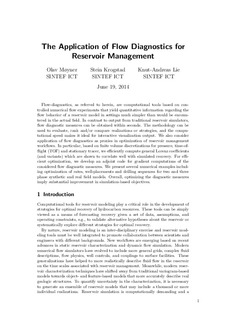| dc.contributor.author | Møyner, Olav | |
| dc.contributor.author | Krogstad, Stein | |
| dc.contributor.author | Lie, Knut-Andreas | |
| dc.date.accessioned | 2017-12-20T07:46:18Z | |
| dc.date.available | 2017-12-20T07:46:18Z | |
| dc.date.created | 2014-09-26T17:14:03Z | |
| dc.date.issued | 2014 | |
| dc.identifier.citation | SPE Journal. 2014, 20 (2), 306-323. | nb_NO |
| dc.identifier.issn | 1086-055X | |
| dc.identifier.uri | http://hdl.handle.net/11250/2473111 | |
| dc.description.abstract | Flow diagnostics, as referred to herein, are computational tools derived from controlled numerical flow experiments that yield quantitative information regarding the flow behavior of a reservoir model in settings much simpler than would be encountered in the actual field. In contrast to output from traditional reservoir simulators, flow-diagnostic measures can be obtained within seconds. The methodology can be used to evaluate, rank, and/or compare realizations or strategies, and the computational speed makes it ideal for interactive visualization output. We also consider application of flow diagnostics as proxies in optimization of reservoir-management work flows. In particular, by use of finite-volume discretizations for pressure, time of flight (TOF), and stationary tracers, we efficiently compute general Lorenz coefficients (and variants) that are shown to correlate well with simulated recovery. For efficient optimization, we develop an adjoint code for gradient computations of the considered flow-diagnostic measures. We present several numerical examples, including optimization of rates, well placements, and drilling sequences for two- and three-phase synthetic and real field models. Overall, optimizing the diagnostic measures implies substantial improvement in simulation-based objectives. | nb_NO |
| dc.language.iso | eng | nb_NO |
| dc.title | The application of flow diagnostics for reservoir management | nb_NO |
| dc.type | Journal article | nb_NO |
| dc.type | Peer reviewed | nb_NO |
| dc.description.version | submittedVersion | nb_NO |
| dc.subject.nsi | VDP::Anvendt matematikk: 413 | nb_NO |
| dc.subject.nsi | VDP::Applied mathematics: 413 | nb_NO |
| dc.source.pagenumber | 306-323 | nb_NO |
| dc.source.volume | 20 | nb_NO |
| dc.source.journal | SPE Journal | nb_NO |
| dc.source.issue | 2 | nb_NO |
| dc.identifier.doi | 10.2118/171557-PA | |
| dc.identifier.cristin | 1158751 | |
| dc.relation.project | Norges forskningsråd: 215665 | nb_NO |
| dc.relation.project | Andre: Chevron Energy Technology Company | nb_NO |
| dc.relation.project | Norges teknisk-naturvitenskapelige universitet: Center for Integrated Operations in the Petroleum Industry | nb_NO |
| cristin.unitcode | 7401,90,11,0 | |
| cristin.unitname | Anvendt matematikk | |
| cristin.ispublished | true | |
| cristin.fulltext | preprint | |
| cristin.qualitycode | 2 | |
